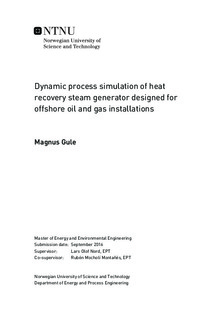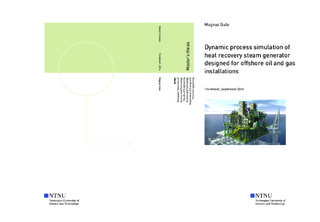| dc.description.abstract | In the offshore oil and gas sector combined cycle (CC) technology is a viable alternative to the traditional gas turbines and land-based power supply on both platforms and FPSOs. In 2015 gas turbines accounted alone for 81% of all greenhouse emitted on the Norwegian Continental Shelf. If integrating heat recovery steam generators (HRSGs) to these gas turbines with corresponding steam turbines, power output can be increased by 50 percent compared to a single gas-turbine cycle.
In Europa, modelling the dynamics of combined cycles have been of growing interest since the beginning of 2000, and especially lately with eruptive marked renewables. Most dynamic modelling software are based on conventional drum-based HRSGs, but few have specialized in once-through systems which is desired in offshore operations due of its fast cycle characteristics.
A comparative literature study of different HRSG-skids was evaluated together with different part-load control systems for the steam cycle. A set of open-source libraries were evaluated and compared in detail for modelling of a once-through steam cycle from steady-state data resembling the CC from Oseberg D. Heat transfer correlations (HTC) for the HRSG including ESCOA, VDI and Næss was rated and implemented in a final model built by the library ClaRa and transients simulated through part-load gas turbine operation.
Feedwater and condenser controls were implemented, but the lack of both dynamic and stable heat exchanger models limits the applicability for simulating real transients. Incomplete libraries, lack of documentation and low level of detail resulted a custom heat exchanger being built including heat transfer correlations of Næss. Due to high complexity and instability of the current model, implementing more control systems and detailed steam models seems improbable. Suggested strategies to improve the model further includes removal of visualization components and replace models with lower level of detail including valves, water tanks and pipes, as well as the completion of the an ESCOA heat exchanger model. | |

